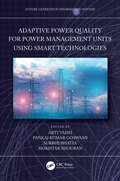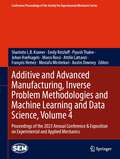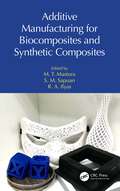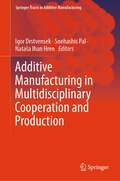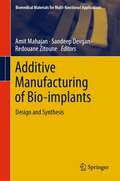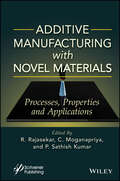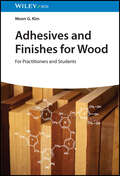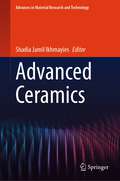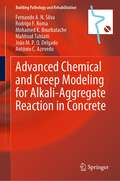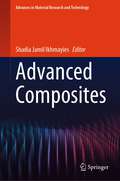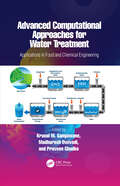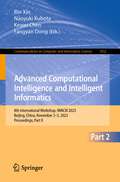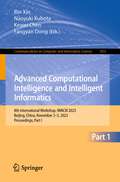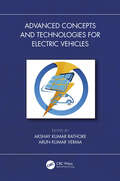- Table View
- List View
Adaptive Power Quality for Power Management Units using Smart Technologies (Future Generation Information Systems)
by Arti Vaish Pankaj Kumar Goswami Surbhi Bhatia Mokhtar ShouranThis book covers issues associated with smart systems due to the presence of onboard nonlinear components. It discusses the advanced architecture of smart systems for power management units. It explores issues of power management and identifies hazardous signals in the power management units of smart devices. It Presents adaptive artificial intelligence and machine learning-based control strategies. Discusses advanced simulations and data synthesis for various power management issues. Showcases solutions to the uncertainty and reliability issues in power management units. Identifies new power quality challenges in smart devices. Explains hybrid active power filters, shunt hybrid active power filters, and the industrial internet of things in power quality management. This book comprehensively discusses advancements of traditional electrical grids, the benefits of smart grids to customers and stakeholders, properties of smart grids, smart grid architecture, smart grid communication, and smart grid security. It further covers the architecture of advance power management units (PMU) of smart devices, and the identification of harmonic distortions with respect to various sensor-based technology. It will serve as an ideal reference text for senior undergraduate and graduate students, and academic researchers in fields including electrical engineering, electronics, communications engineering, and computer engineering.
Adaptive Power Quality for Power Management Units using Smart Technologies (Future Generation Information Systems)
by Arti Vaish Pankaj Kumar Goswami Surbhi Bhatia Mokhtar ShouranThis book covers issues associated with smart systems due to the presence of onboard nonlinear components. It discusses the advanced architecture of smart systems for power management units. It explores issues of power management and identifies hazardous signals in the power management units of smart devices. It Presents adaptive artificial intelligence and machine learning-based control strategies. Discusses advanced simulations and data synthesis for various power management issues. Showcases solutions to the uncertainty and reliability issues in power management units. Identifies new power quality challenges in smart devices. Explains hybrid active power filters, shunt hybrid active power filters, and the industrial internet of things in power quality management. This book comprehensively discusses advancements of traditional electrical grids, the benefits of smart grids to customers and stakeholders, properties of smart grids, smart grid architecture, smart grid communication, and smart grid security. It further covers the architecture of advance power management units (PMU) of smart devices, and the identification of harmonic distortions with respect to various sensor-based technology. It will serve as an ideal reference text for senior undergraduate and graduate students, and academic researchers in fields including electrical engineering, electronics, communications engineering, and computer engineering.
Additive and Advanced Manufacturing, Inverse Problem Methodologies and Machine Learning and Data Science, Volume 4: Proceedings of the 2023 Annual Conference & Exposition on Experimental and Applied Mechanics (Conference Proceedings of the Society for Experimental Mechanics Series)
by Sharlotte L. B. Kramer Emily Retzlaff Piyush Thakre Johan Hoefnagels Marco Rossi Attilio Lattanzi François Hemez Mostafa Mirshekari Austin DowneyAdditive and Advanced Manufacturing, Inverse Problem Methodologies and Machine Learning and Data Science, Volume 4 of the Proceedings of the 2023 SEM Annual Conference & Exposition on Experimental and Applied Mechanics, the fourth volume of five from the Conference, brings together contributions to this important area of research and engineering. The collection presents early findings and case studies on a wide range of topics and includes papers in the following general technical research areas: AM Composites and Polymers Dynamic Behavior of Additively Manufactured Materials and Structures Joint Residual Stress and Additive Manufacturing ML for Material Model Identification Novel AM Structures Novel Processing and Testing of Additively Manufactured Materials Plasticity and Complex Material Behavior Virtual Fields Method
Additive Manufacturing for Biocomposites and Synthetic Composites
by M. T. Mastura S. M. Sapuan R. A. IlyasAdditive Manufacturing for Biocomposites and Synthetic Composites focuses on processes, engineering, and product design applications of bio-composites and synthetic composites in additive manufacturing (AM). It discusses the preparation and material characterization and selection, as well as future opportunities and challenges. Reviews the latest research on the development of composites for AM and the preparation of composite feedstocks Offers an analytical and statistical approach for the selection of composites for AM, including characterization of material properties Emphasizes the use of environmentally friendly composites Analyzes the lifecycle including costs Considers potential new fibers, their selection, and future applications This book provides a comprehensive overview of the application of advanced composite materials in AM and is aimed at researchers, engineers, and advanced students in materials and manufacturing engineering and related disciplines.
Additive Manufacturing for Biocomposites and Synthetic Composites
by M. T. Mastura S. M. Sapuan R. A. IlyasAdditive Manufacturing for Biocomposites and Synthetic Composites focuses on processes, engineering, and product design applications of bio-composites and synthetic composites in additive manufacturing (AM). It discusses the preparation and material characterization and selection, as well as future opportunities and challenges. Reviews the latest research on the development of composites for AM and the preparation of composite feedstocks Offers an analytical and statistical approach for the selection of composites for AM, including characterization of material properties Emphasizes the use of environmentally friendly composites Analyzes the lifecycle including costs Considers potential new fibers, their selection, and future applications This book provides a comprehensive overview of the application of advanced composite materials in AM and is aimed at researchers, engineers, and advanced students in materials and manufacturing engineering and related disciplines.
Additive Manufacturing for Construction
by Biranchi Panda Pshtiwan N. Shakor Vittoria LaghiAdditive Manufacturing for Construction reveals additive manufacturing technologies for building and construction applications. It introduces digital and multiuse technologies for civil applications and informs the reader of their design properties and uses. The book explores on-site and off-site construction techniques, and features design strategies in additive manufacturing which will eliminate production difficulties and minimise assembly costs, from both the academic and the industrial perspectives. The unique capabilities of additive manufacturing technologies for large-scale applications combined with 'design for manufacturing' strategies are shown, allowing the reader to understand efficient structural shapes and forms which can provide appropriate level of structural performance with reduced use of materials and resources. This book gathers knowledge of multidisciplinary investigations into one book to answer challenges and difficulties faced by the construction industry and includes: extrusion-based concrete additive manufacturing particle bed additive manufacturing shotcrete additive manufacturing wire-and-arc metal additive manufacturing simulation modelling of concrete 3D printing Additive Manufacturing for Construction is of interest to those in academia and industry including architects, civil engineers, material engineers, manufacturing and industrial engineers, mechatronic engineers and construction experts with an interest/professional requirement to know about large-scale additive manufacturing technologies.
Additive Manufacturing in Multidisciplinary Cooperation and Production (Springer Tracts in Additive Manufacturing)
by Igor Drstvensek Snehashis Pal Nataša Ihan HrenThis book publishes the latest findings and ideas in the field of additive manufacturing presented by authors from prominent institutions around the world at the iCAT 2023 conference. The authors address various technological and medical aspects, ranging from materials science to the specific behaviour of the technology under different working conditions. The book is divided into four sections, three of which are dedicated to the purely technological aspects of additive manufacturing, covering metal processes, polymer processes and simulation. The fourth part of the book is dedicated to the medical applications of additive manufacturing, covering areas ranging from orthopaedic surgeries to materials used in medical AM.Overall, the book provides insight into the current state of the science and applications of additive manufacturing.
Additive Manufacturing of Bio-implants: Design and Synthesis (Biomedical Materials for Multi-functional Applications)
by Amit Mahajan Sandeep Devgan Redouane ZitouneThis contributed volume presents the latest research on additive manufacturing (AM) or 3D printing, one of the key techniques of novel medical devices, which can process complicated or customized structures to match the properties of human tissues. AM allows for the fabrication of devices with optimal architectures, complicated morphologies, surface integrity, and regulated porosity and chemical composition. Various AM methods can now consistently fabricate dense products for a variety of materials, comprising steels, titanium alloys, Co-Cr alloys, metal-based composites, and nanocomposites. This book elucidates the chronology of various techniques that are categorized under additive manufacturing. Moreover, the futuristic techniques or advancements in this area are also described. The available literature focuses on the microstructure and various properties of 3D-printed alloys. However, the research on the wear characteristics, corrosion resistance, and biocompatibility of 3D-printed technology for biomedical applications is limited. This book comprises the helicopter view of different surface analysis trends of additive manufactured alloys. The book can be a valuable reference for beginners, researchers, and professionals interested in bioimplant manufacturing and allied fields.
Additive Manufacturing with Novel Materials: Process, Properties and Applications
by R. Rajasekar C. Moganapriya P. Sathish KumarADDITIVE MANUFACTURING With NOVEL MATERIALS The book explores practically the latest advancements and techniques in 3D and 4D printing using innovative and unconventional materials. This book comprehensively provides insights into various additive manufacturing processes, novel materials, and their properties, as well as the basic knowledge of AM process parameters, post-processing techniques, and their applications. It also explores the fundamental concepts and recent advancements in the development of novel materials for several applications, with special emphasis on platforms like AM techniques for polymers, ceramics, metallic materials, composites, nanomaterials, hydrogels, etc. Specific topics like environmental aspects of 3D printing and advanced 4D printing are also introduced. The technological aspects of AM are discussed in a concise and understandable way, with extensive illustrations. Also covered are the challenges and opportunities that arise from 3D printing with these materials. Audience The book will benefit researchers and industry engineers who work in additive manufacturing, mechanical engineering, 3D/4D printing, and materials science.
Additive Manufacturing with Novel Materials: Process, Properties and Applications
by R. Rajasekar C. Moganapriya P. Sathish KumarADDITIVE MANUFACTURING With NOVEL MATERIALS The book explores practically the latest advancements and techniques in 3D and 4D printing using innovative and unconventional materials. This book comprehensively provides insights into various additive manufacturing processes, novel materials, and their properties, as well as the basic knowledge of AM process parameters, post-processing techniques, and their applications. It also explores the fundamental concepts and recent advancements in the development of novel materials for several applications, with special emphasis on platforms like AM techniques for polymers, ceramics, metallic materials, composites, nanomaterials, hydrogels, etc. Specific topics like environmental aspects of 3D printing and advanced 4D printing are also introduced. The technological aspects of AM are discussed in a concise and understandable way, with extensive illustrations. Also covered are the challenges and opportunities that arise from 3D printing with these materials. Audience The book will benefit researchers and industry engineers who work in additive manufacturing, mechanical engineering, 3D/4D printing, and materials science.
Addressing the Climate Crisis in the Indian Himalayas: Can Traditional Ecological Knowledge Help?
by Anwesha Borthakur Pardeep SinghThis book focuses on the traditional ecological knowledge in addressing the current climate crisis in the Indian Himalayas. Local or indigenous people in the Himalayas, through their low-carbon producing lifestyles, contribute very little to the climate crisis. However, at the same time, they bear the brunt of this crisis way more than many others. It is important to learn about their traditional ways of life and the knowledge that they hold regarding ecology and environment. Traditional ecological knowledge and associated belief systems are given increasing attention across the globe in recent times toward addressing some of the grave environmental concerns. Climate change is one such concern. The rising consideration of concepts such as ethnoecology and ethnobotany signifies the scientific, socio-cultural and economic potential of the traditional ecological knowledge systems. It is indisputable that these knowledge systems have the ability to provide important insights towards tackling many present-day environmental distresses including several climate change challenges. In this book, the authors concentrate on such traditional ecological knowledge systems in the Indian Himalayan region and try to figure out their significance in relation to the modern science. Overall, the authors attempt to write a book where the relevance of traditional ecological knowledge systems could be addressed and communicated to a larger audience—both academic scientific and non-academic.
Adhesives and Finishes for Wood: For Practitioners and Students
by Moon G. KimAdhesives and Finishes for Wood Understand the science of joining wood with this comprehensive guide Long seen as an old-fashioned material with narrowing modern applications, wood has seen increased popularity as a material in building and manufacturing in recent years. This has been driven by the need for sustainable resources and environmentally friendly materials. As a result of increased emphasis on wood, however, there is a corresponding need to understand the wood adhesives, the crucial materials in wood-based manufacture and craftsmanship. Adhesives and Finishes for Wood meets this need with a comprehensive but accessible introduction to the chemistry and applications of wood adhesives. Its easy-to-follow presentation nonetheless presents wood adhesives and finishes in significant detail. Ideal for readers without considerable preexisting knowledge in chemistry, this book includes everything the reader needs to understand and apply wood adhesives in their work or industry. Adhesives and Finishes for Wood readers will also find: Coverage ranging from the fundamentals of wood adhesive polymer chemistry to the properties of specific wood structures and resins A presentation suitable for both academic students and wood manufacture professionals An author with decades of experience in both academia and industry Adhesives and Finishes for Wood is a useful reference for advanced students and professionals in industries or manufacturing disciplines that incorporate wood, as well as for chemists, materials scientists, vocational school instructors, and more.
Adhesives and Finishes for Wood: For Practitioners and Students
by Moon G. KimAdhesives and Finishes for Wood Understand the science of joining wood with this comprehensive guide Long seen as an old-fashioned material with narrowing modern applications, wood has seen increased popularity as a material in building and manufacturing in recent years. This has been driven by the need for sustainable resources and environmentally friendly materials. As a result of increased emphasis on wood, however, there is a corresponding need to understand the wood adhesives, the crucial materials in wood-based manufacture and craftsmanship. Adhesives and Finishes for Wood meets this need with a comprehensive but accessible introduction to the chemistry and applications of wood adhesives. Its easy-to-follow presentation nonetheless presents wood adhesives and finishes in significant detail. Ideal for readers without considerable preexisting knowledge in chemistry, this book includes everything the reader needs to understand and apply wood adhesives in their work or industry. Adhesives and Finishes for Wood readers will also find: Coverage ranging from the fundamentals of wood adhesive polymer chemistry to the properties of specific wood structures and resins A presentation suitable for both academic students and wood manufacture professionals An author with decades of experience in both academia and industry Adhesives and Finishes for Wood is a useful reference for advanced students and professionals in industries or manufacturing disciplines that incorporate wood, as well as for chemists, materials scientists, vocational school instructors, and more.
Advanced Ceramics (Advances in Material Research and Technology)
by Shadia Jamil IkhmayiesThis book presents the fundamentals of advanced ceramics, their stages of development, types and classifications, advanced processing techniques, properties, sintering, and new forms of applications. It highlights specific examples such as alumina, zirconia, Mg-Al-spinels, silicon carbide, silicon nitride, ceramic composites, and thin films with their specific applications. The book reviews progress in perovskite ceramics, in which the synthesis, processing, characterization, and advanced applications of perovskite ceramics are all thoroughly discussed. In addition, developments of perovskite solar cells, the main factors affecting their stability, current problems, development prospects in the research, and application of perovskite solar cells are all highlighted. This book also includes a review of a particular class of rare-earth-based mixed-metal oxides, namely Ln2B2O7 nanostructures (B = Zr, Sn, and Ce), where advantages and disadvantages of each production technique are addressed along with the properties of as-produced nanostructures. The solar photocatalytic uses of Ln2B2O7 nanostructures such as photodegradation of contaminants are also discussed. Yttria-based transparent ceramics for photonic applications are reviewed, along with a discussion of powder synthesis, green body preparation, sintering, and optical properties. In addition, the fundamentals of electrophoretic deposition of hydroxyapatite incorporated composite coatings on metallic substrates are presented and discussed. The different types of ceramics-based self-healing coatings and their fabrication processes have also been reported and discussed in this book. These include titania, zirconia, titanium-alumina, and zirconia-alumina incorporated with Benzotriazole (BTA) as an inhibitor. Advanced ceramic materials that have been used for the purpose of wastewater treatment including ceramic sorbents, resins, aerosols, and ceramic membranes that have been widely used for wastewater treatment purposes are also discussed in depth.Moreover, the book presents the preparation of geopolymers by microwave treatments and explains how their properties can be tuned using microwaves. Furthermore, the future and perspective of these advanced ceramic materials and their modifications to ensure better efficacy toward environmental remediation purposes are highlighted in this book.
Advanced Chassis Control Technology for Steer-by-Wire Vehicles
by Xiaodong WuAdvanced Chassis Control Technology for Steer-by-Wire Vehicles details state-of-the-art drive-by-wire technology, enabling engineers to create safer and smarter steering technology. With applications in Formula 1 driving, this book is an accessible yet ambitious introduction to the technology that is fast becoming the future of road vehicles.Steer-by-wire systems replace conventional mechanical technology with electronic sensors, controllers, and actuators, enhancing functionality when steering. Features such as variable steer ratio, customized road feel, and advanced vehicle dynamics control all ensure that this maximizes safety when driving. The book looks first at the theory behind this technology and compares it to conventional mechanical steering. It discusses control through forward and backward dynamics and a shared steering control concept to improve vehicle handling and performance, relevant to intelligent vehicles. It also explains how to create chassis domain fusion control, four independent wheels steering system and teleoperated control. Using case studies and ISOs, the book is a practical guide to safely designing steer-by-wire systems.The book is an essential guide to all engineers working in the modern automotive industry.
Advanced Chassis Control Technology for Steer-by-Wire Vehicles
by Xiaodong WuAdvanced Chassis Control Technology for Steer-by-Wire Vehicles details state-of-the-art drive-by-wire technology, enabling engineers to create safer and smarter steering technology. With applications in Formula 1 driving, this book is an accessible yet ambitious introduction to the technology that is fast becoming the future of road vehicles.Steer-by-wire systems replace conventional mechanical technology with electronic sensors, controllers, and actuators, enhancing functionality when steering. Features such as variable steer ratio, customized road feel, and advanced vehicle dynamics control all ensure that this maximizes safety when driving. The book looks first at the theory behind this technology and compares it to conventional mechanical steering. It discusses control through forward and backward dynamics and a shared steering control concept to improve vehicle handling and performance, relevant to intelligent vehicles. It also explains how to create chassis domain fusion control, four independent wheels steering system and teleoperated control. Using case studies and ISOs, the book is a practical guide to safely designing steer-by-wire systems.The book is an essential guide to all engineers working in the modern automotive industry.
Advanced Chemical and Creep Modeling for Alkali-Aggregate Reaction in Concrete (Building Pathology and Rehabilitation #28)
by Fernando A. Silva Rodrigo F. Roma Mohamed K. Bourbatache Mahfoud Tahlaiti João M. Delgado António C. AzevedoThis book presents the numerical results of the use of the chemical model to analyse the advancement of the reaction and the mechanical model to simulate creep and shrinkage phenomena in COMSOL Multiphysics®, as a way to reassess concrete structures suffering from those mechanisms. Both models were implemented separately to evaluate their responses and compare them with the theoretical results and experimental benchmarks presented in the literature. The numerical simulation results showed excellent agreement with the experimental results data, with maximum disagreement not exceeding 10%, indicating that the implementation of the developed numerical models behaved very efficiently.
Advanced Composites (Advances in Material Research and Technology)
by Shadia Jamil IkhmayiesThis book presents a comprehensive collection of reviews and experimental research findings in the realm of composite materials. It explores manufacturing technologies and applications, as well as recent breakthroughs in nanomaterial-based composites, polymer-based composites, titanium matrix composites (TMCs), conducting polymers, natural polymers, graphene polymers, graphene composites, and organosulfur polymeric composites, alongside reinforced aluminum matrix composites. The mechanical and tribological aspects take center stage, with a focus on aluminum alloy composites as a superior alternative to traditional gear materials. The book also addresses cutting-edge composite materials developed for drug removal via adsorption techniques, radiation shielding, and their use as shielding absorbers for ionizing radiation. Furthermore, the significance of electrical contact materials and their performance is explored. The book unveils fabrication methods, sample preparation techniques, properties, and various applications of these remarkable composites. Topics range from additive manufacturing to solid-phase extraction and solid-phase microextraction utilizing diverse composites as adsorbents. Additionally, the inverse vulcanization process, a novel technique involving the copolymerization of elemental sulfur with different monomers based on their resource origins, is discussed. Technologies such as powder metallurgy (PM), mechanical alloying (MA), self-propagating high-temperature synthesis (SHS), and rapid solidification processing (RSP) are described. The book further delves into the preparation techniques of zeolite using both conventional and advanced methods, along with the synthesis of various zeolite-based composites, particularly their application in environmental remediation. The book culminates with a summary of analysis and modeling techniques used in composite materials, including those employed in ballistic applications.
Advanced Computational Approaches for Water Treatment: Applications in Food and Chemical Engineering
by Krunal M Gangawane Madhuresh Dwivedi Praveen GhodkeA rapid growth in global industrialization and population has triggered intense environmental pollution that has led to a water crisis, resulting in the decay in the quality of human life and economic losses. Novel water purification techniques are expected to alleviate this challenge. Recently, various water purification techniques, along with different computational techniques, have been developed. For instance, water purification techniques, such as electromagnetic water purification, solute-surface interactions in water, use of micro-magnetofluidic devices, UV-led water purification, and use of membranes can be thoroughly investigated by using a range of computation techniques, such as molecular dynamics, the lattice Boltzmann method, and the Navier-Stokes method-based solver. Advanced Computational Approaches for Water Treatment: Applications in Food and Chemical Engineering, presents these different numerical techniques and traditional modeling and simulation approaches to elaborate on and explain the various water purification techniques. Features: Serves as a dedicated reference for this emerging topic Discusses state of the art developments in advanced computational techniques for water purification Brings together diverse experience in this field in one reference text Provides a roadmap for future developments in the area This book is primarily intended for chemical engineers, hydrologists, water resource managers, civil engineers, environmental engineers, food scientists and food engineers interested in understanding the numerical approaches for different water purification techniques, such as membrane, sedimentation, filtration, micromagnetofluidic device, and ozone/UV, among others.
Advanced Computational Approaches for Water Treatment: Applications in Food and Chemical Engineering
by Krunal M. Gangawane Madhuresh Dwivedi Praveen GhodkeA rapid growth in global industrialization and population has triggered intense environmental pollution that has led to a water crisis, resulting in the decay in the quality of human life and economic losses. Novel water purification techniques are expected to alleviate this challenge. Recently, various water purification techniques, along with different computational techniques, have been developed. For instance, water purification techniques, such as electromagnetic water purification, solute-surface interactions in water, use of micro-magnetofluidic devices, UV-led water purification, and use of membranes can be thoroughly investigated by using a range of computation techniques, such as molecular dynamics, the lattice Boltzmann method, and the Navier-Stokes method-based solver. Advanced Computational Approaches for Water Treatment: Applications in Food and Chemical Engineering, presents these different numerical techniques and traditional modeling and simulation approaches to elaborate on and explain the various water purification techniques. Features: Serves as a dedicated reference for this emerging topic Discusses state of the art developments in advanced computational techniques for water purification Brings together diverse experience in this field in one reference text Provides a roadmap for future developments in the area This book is primarily intended for chemical engineers, hydrologists, water resource managers, civil engineers, environmental engineers, food scientists and food engineers interested in understanding the numerical approaches for different water purification techniques, such as membrane, sedimentation, filtration, micromagnetofluidic device, and ozone/UV, among others.
Advanced Computational Intelligence and Intelligent Informatics: 8th International Workshop, IWACIII 2023, Beijing, China, November 3–5, 2023, Proceedings, Part II (Communications in Computer and Information Science #1932)
by Bin Xin Naoyuki Kubota Kewei Chen Fangyan DongThis two-volume set constitutes the refereed proceedings of the 8th International Workshop on Advanced Computational Intelligence and Intelligent Informatics, IWACIII 2023, held in Beijing, China, in November 2023.The 56 papers presented were thoroughly reviewed and selected from the 118 qualifies submissions. They are organized in the topical sections on intelligent information processing; intelligent optimization and decision-making; pattern recognition and computer vision; advanced control; multi-agent systems; robotics.
Advanced Computational Intelligence and Intelligent Informatics: 8th International Workshop, IWACIII 2023, Beijing, China, November 3–5, 2023, Proceedings, Part I (Communications in Computer and Information Science #1931)
by Bin Xin Naoyuki Kubota Kewei Chen Fangyan DongThis two-volume set constitutes the refereed proceedings of the 8th International Workshop on Advanced Computational Intelligence and Intelligent Informatics, IWACIII 2023, held in Beijing, China, in November 2023.The 56 papers presented were thoroughly reviewed and selected from the 118 qualifies submissions. They are organized in the topical sections on intelligent information processing; intelligent optimization and decision-making; pattern recognition and computer vision; advanced control; multi-agent systems; robotics.
Advanced Concepts and Technologies for Electric Vehicles
This book explains the basic and advanced technology behind the Power Electronics Converters for EV charging, and their significant developments, and introduces the Grid Impact issues that underpin the grid integration of electric vehicles. Advanced Concepts and Technologies for Electric Vehicles reviews state-of-the-art and new configurations and concepts of more electric vehicles and EV charging, mitigating the impact of EV charging on the power grid, and technical considerations of EV charging infrastructures. The book considers the environmental benefits and advantages of electric vehicles and their component devices. It includes case studies of different power electronic converters used for charging EVs. It offers a review of PFC-based AC chargers, WBG-based chargers, and Wireless chargers. The authors also explore multistage charging systems and their possible implementations. The book also examines the challenges and opportunities posed by the progressive integration of electric drive vehicles on the power grid and reported solutions for their mitigation. The book is intended for professionals, researchers, and engineers in the electric vehicle industry as well as advanced students in electrical engineering who benefit from this comprehensive coverage of electric vehicle technology. Readers can get an in-depth insight into the technology deployment in EV transportation and utilize that knowledge to develop novel ideas in the EV area.
Advanced Concepts and Technologies for Electric Vehicles
by Akshay Kumar Rathore Arun Kumar VermaThis book explains the basic and advanced technology behind the Power Electronics Converters for EV charging, and their significant developments, and introduces the Grid Impact issues that underpin the grid integration of electric vehicles. Advanced Concepts and Technologies for Electric Vehicles reviews state-of-the-art and new configurations and concepts of more electric vehicles and EV charging, mitigating the impact of EV charging on the power grid, and technical considerations of EV charging infrastructures. The book considers the environmental benefits and advantages of electric vehicles and their component devices. It includes case studies of different power electronic converters used for charging EVs. It offers a review of PFC-based AC chargers, WBG-based chargers, and Wireless chargers. The authors also explore multistage charging systems and their possible implementations. The book also examines the challenges and opportunities posed by the progressive integration of electric drive vehicles on the power grid and reported solutions for their mitigation. The book is intended for professionals, researchers, and engineers in the electric vehicle industry as well as advanced students in electrical engineering who benefit from this comprehensive coverage of electric vehicle technology. Readers can get an in-depth insight into the technology deployment in EV transportation and utilize that knowledge to develop novel ideas in the EV area.
Advanced Control of Grid-Integrated Renewable Energy Power Plants: LMI-based Design in the Takagi-Sugeno Framework (IEEE Press)
by Horst SchultePresents the principles, derivations, and equations of renewable energy power plants, including MATLAB code Advanced Control of Grid-Integrated Renewable Energy Power Plants presents a comprehensive introduction to the power system dynamics and stability of renewable energy power plants (RPPs), such as wind turbines, wind power plants, and photovoltaic systems. The author—a noted expert on the topic—takes a rigorous approach to the analysis and modelling of RPPs, such as turbine rotors, PV cells, electronic converters, transformers, and aggregated grid models. This approach allows for the validation of requirements for sustainable power systems based on formal methods. The text deals with nonlinear model-based observer and control design techniques in the Takagi-Sugeno (TS) framework. It explores the Takagi-Sugeno fuzzy (TSF) models which are nonlinear systems, in which the consequent part of a fuzzy rule is a mathematical formula, representing local dynamics or limited nonlinearities by sector functions. The strong property of the TSF finds several applications modelling dynamical systems that can be described by differential equations. The book’s practical exercises use MATLAB code to help model simulation models of single large-scale wind turbines, wind farms, and photovoltaic plants. This important book: Provides a complete introduction to the power system dynamics and stability of renewable energy power plants Includes a detailed discussion of how to design model model-based controllers for RPPs Takes a rigorous approach to the analysis and modelling of RPPs, including turbine rotors, PV cells, electronic converters, transformers, aggregated grid models, and more Includes MATLAB code to model simulation models of single large-scale wind turbines, wind farms, and photovoltaic plants Written for students and researchers of renewable energy, Advanced Control of Grid-Integrated Renewable Energy Power Plants offers an authoritative text to the topic.
